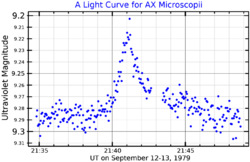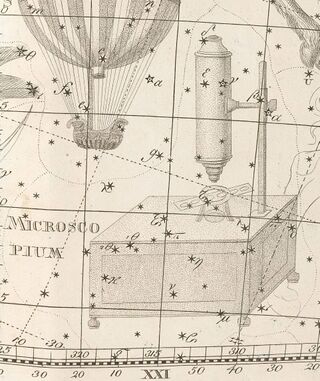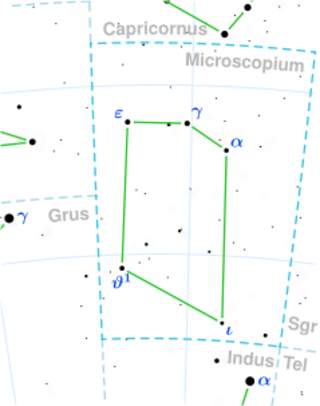Astronomy:Lacaille 8760
Coordinates: ![]() 21h 17m 15.269s, −38° 52′ 02.51″
21h 17m 15.269s, −38° 52′ 02.51″
| Observation data Equinox J2000.0]] (ICRS) | |
|---|---|
| Constellation | Microscopium |
| Right ascension | 21h 17m 15.269s[3] |
| Declination | −38° 52′ 02.51″[3] |
| Apparent magnitude (V) | 6.67[4] |
| Characteristics | |
| Spectral type | M0Ve[5][6] |
| U−B color index | +1.165[5] |
| B−V color index | +1.395[5] |
| Variable type | Flare star |
| Astrometry | |
| Radial velocity (Rv) | +20.7[6] km/s |
| Proper motion (μ) | RA: −3,258.553[3] mas/yr Dec.: −1,145.396[3] mas/yr |
| Parallax (π) | 251.9124 ± 0.0352[7] mas |
| Distance | 12.947 ± 0.002 ly (3.9696 ± 0.0006 pc) |
| Absolute magnitude (MV) | 8.69[4] |
| Details | |
| Mass | 0.60[4] M☉ |
| Radius | 0.51[8] R☉ |
| Luminosity (bolometric) | 0.072[9] L☉ |
| Luminosity (visual, LV) | 0.029 L☉ |
| Surface gravity (log g) | 4.78[8] cgs |
| Temperature | 3,800[10] K |
| Metallicity [Fe/H] | −0.01±0.04[11] dex |
| Rotation | 40±12 d[12] |
| Rotational velocity (v sin i) | 3.3[6] km/s |
| Age | 4.8±2.9[13] Gyr |
| Other designations | |
| Database references | |
| SIMBAD | data |
| Exoplanet Archive | data |
| ARICNS | data |
Location of Lacaille 8760 in the constellation Microscopium | |
Lacaille 8760 (AX Microscopii) is a red dwarf star in the constellation Microscopium. It is one of the nearest stars to the Sun at about 12.9 light-years' distance, and the brightest M-class main-sequence star in Earth's night sky, although it is generally too faint to be seen without a telescope. At an apparent magnitude of +6.7, it may only be visible to the unaided eye under exceptionally good viewing conditions, under dark skies.
This star was originally listed in a 1763 catalog that was published posthumously by the France Abbé Nicolas-Louis de Lacaille. He observed it in the southern sky while working from an observatory at the Cape of Good Hope.[14] Number 8760 was assigned to this star in the 1847 edition of Lacaille's catalogue of 9,766 stars by Francis Baily.[15]
In the past, Lacaille 8760 has been classified anywhere from spectral class K7 down to M2. In 1979, the Irish astronomer Patrick Byrne discovered that it is a flare star,[16] and it was given the variable star designation AX Microscopii, or AX Mic. As a flare star it is relatively quiescent.

Lacaille 8760 is one of the largest and brightest red dwarfs known, with about 60%[4] the mass and 51%[8] the radius of the Sun. It is about five[13] billion years old and is spinning at a projected rotational velocity of 3.3 km/s,[6] giving it a rotation period of roughly 40 days.[12] The star is radiating 7.2%[9] of the luminosity of the Sun from its photosphere at an effective temperature of 3,800 K.[10]
Despite efforts by astronomers, as of 2011 no planets had been detected in orbit around this star.[17]
Lacaille 8760 orbits around the galaxy with a relatively high ellipticity of 0.23.[18] Its closest approach to the Sun occurred about 20,000 years ago when it came within 12 light-years (3.7 parsecs).[19] Due to its low mass (60% of the Sun), it has an expected lifespan of about 75 billion (7.5 × 1010) years,[20] seven times longer than the Sun's.
References
- ↑ e-rara.ch. Johann Elert Bode. Uranographia star atlas (1801), Tabula XVI
- ↑ Johann Elert Bode. Allgemeine Beschreibung und Nachweisung der Gestirne (1801), Page 67
- ↑ 3.0 3.1 3.2 Brown, A. G. A. (August 2018). "Gaia Data Release 2: Summary of the contents and survey properties". Astronomy & Astrophysics 616: A1. doi:10.1051/0004-6361/201833051. Bibcode: 2018A&A...616A...1G. Gaia DR2 record for this source at VizieR.
- ↑ 4.0 4.1 4.2 4.3 "The One Hundred Nearest Star Systems", RECONS (Georgia State University), http://www.astro.gsu.edu/RECONS/TOP100.posted.htm, retrieved 2015-06-25.
- ↑ 5.0 5.1 5.2 5.3 "V* AX Mic -- Flare Star", SIMBAD (Centre de Données astronomiques de Strasbourg), http://simbad.u-strasbg.fr/simbad/sim-id?Ident=AX+Mic, retrieved 2011-02-18.
- ↑ 6.0 6.1 6.2 6.3 Torres, C. A. O. et al. (December 2006), "Search for associations containing young stars (SACY). I. Sample and searching method", Astronomy and Astrophysics 460 (3): 695–708, doi:10.1051/0004-6361:20065602, Bibcode: 2006A&A...460..695T. See the online data.
- ↑ Brown, A. G. A. (2021). "Gaia Early Data Release 3: Summary of the contents and survey properties". Astronomy & Astrophysics 649: A1. doi:10.1051/0004-6361/202039657. Bibcode: 2021A&A...649A...1G. Gaia EDR3 record for this source at VizieR.
- ↑ 8.0 8.1 8.2 Takeda, Genya et al. (February 2007), "Structure and Evolution of Nearby Stars with Planets. II. Physical Properties of ~1000 Cool Stars from the SPOCS Catalog", The Astrophysical Journal Supplement Series 168 (2): 297–318, doi:10.1086/509763, Bibcode: 2007ApJS..168..297T, http://exoplanets.org/SPOCS_evol.html, retrieved 2011-08-26.
- ↑ 9.0 9.1 Moro-Martín, A. et al. (March 2015). "Does the Presence of Planets Affect the Frequency and Properties of Extrasolar Kuiper Belts? Results from the Herschel Debris and Dunes Surveys". The Astrophysical Journal 801 (2): 28. doi:10.1088/0004-637X/801/2/143. Bibcode: 2015ApJ...801..143M.Vizier catalog entry
- ↑ 10.0 10.1 Gautier, Thomas N., III et al. (September 2007), "Far-Infrared Properties of M Dwarfs", The Astrophysical Journal 667 (1): 527–536, doi:10.1086/520667, Bibcode: 2007ApJ...667..527G.
- ↑ Lindgren, Sara; Heiter, Ulrike (2017). "Metallicity determination of M dwarfs. Expanded parameter range in metallicity and effective temperature". Astronomy and Astrophysics 604: A97. doi:10.1051/0004-6361/201730715. Bibcode: 2017A&A...604A..97L. https://www.aanda.org/articles/aa/full_html/2017/08/aa30715-17/aa30715-17.html.
- ↑ 12.0 12.1 Byrne, P. B.; Doyle, J. G. (January 1989), "Activity in late-type dwarfs. III - Chromospheric and transition region line fluxes for two dM stars", Astronomy and Astrophysics 208 (1–2): 159–165, Bibcode: 1989A&A...208..159B.
- ↑ 13.0 13.1 Boehle, A. et al. (October 2019), "Combining high-contrast imaging and radial velocities to constrain the planetary architectures of nearby stars", Astronomy & Astrophysics 630: 17, doi:10.1051/0004-6361/201935733, A50, Bibcode: 2019A&A...630A..50B.
- ↑ Croswell, Ken (July 2003), "The Brightest Red Dwarf", Sky & Telescope: 32, http://www.kencroswell.com/thebrightestreddwarf.html, retrieved 2011-02-18.
- ↑ Francis Baily. A Catalogue of 9766 Stars (1847), Page 219
- ↑ 16.0 16.1 Byrne, P. B. (April 1981), "Gliese 825 - A new flare star", Monthly Notices of the Royal Astronomical Society 195 (2): 143–147, doi:10.1093/mnras/195.2.143, Bibcode: 1981MNRAS.195..143B.
- ↑ Carson, J. C. et al. (December 2011), "Low-mass evolution - Zero-age main sequence to asymptotic giant branch", The Astrophysical Journal 743 (2): 141, doi:10.1088/0004-637X/743/2/141, Bibcode: 2011ApJ...743..141C.
- ↑ Allen, C.; Herrera, M. A. (April 1998), "The Galactic Orbits of Nearby UV Ceti Stars", Revista Mexicana de Astronomía y Astrofísica 34: 37–46, Bibcode: 1998RMxAA..34...37A.
- ↑ García-Sánchez, J. et al. (2001), "Stellar encounters with the solar system", Astronomy and Astrophysics 379 (2): 634–659, doi:10.1051/0004-6361:20011330, Bibcode: 2001A&A...379..634G, http://www.aanda.org/articles/aa/pdf/2001/44/aah2819.pdf.
- ↑ Despain, K. H. (December 1981), "Low-mass evolution - Zero-age main sequence to asymptotic giant branch", Astrophysical Journal, Part 1 251: 639–653, doi:10.1086/159510, Bibcode: 1981ApJ...251..639D.
External links
 |



